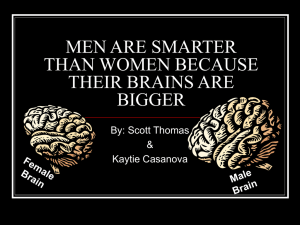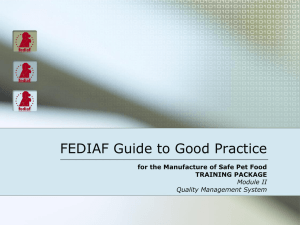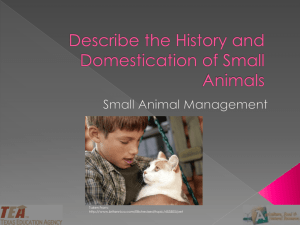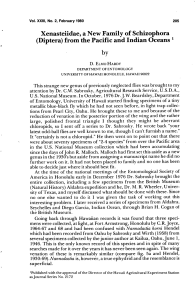Ethanol and the Developing Brain: Molecular, Neurochemical
advertisement
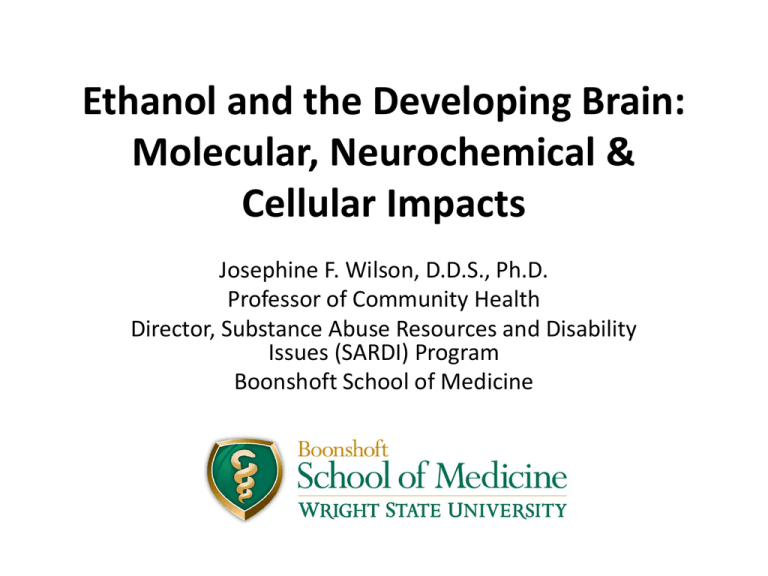
Ethanol and the Developing Brain:
Molecular, Neurochemical &
Cellular Impacts
Josephine F. Wilson, D.D.S., Ph.D.
Professor of Community Health
Director, Substance Abuse Resources and Disability
Issues (SARDI) Program
Boonshoft School of Medicine
The Vulnerable Brain
GLUCOSE
ETHANOL
Metabolites of Ethanol
FORMALDEHYDE
ACETALDEHYDE
Reactive Oxygen Species
Oxidative Stress
Free Radical-Mediated Damage
Alcohol Consumption During Pregnancy
• The leading preventable cause of birth defects
and neurodevelopmental disorders
• Most severe: fetal alcohol syndrome (FAS)
• A continuum of physical anomalies and
behavioral and cognitive deficits: fetal alcohol
spectrum disorders (FASD)
• Some brain areas or cell populations more
vulnerable than others
FASD: Behavioral and Cognitive Deficits
•
•
•
•
•
•
•
•
•
•
General intelligence
Memory
Language
Attention
Learning
Visuospatial abilities
Executive functioning
Fine and gross motor skills
Hyperactive, disruptive, impulsive, delinquent
Depression, anxiety disorders, suicidal ideation, suicide
attempts
• Social and adaptive functioning
• Academic achievement
Biological and Environmental Factors
• Dose of alcohol exposure
• Exposure pattern (binge vs. chronic)
• Developmental timing of exposure
• Genetic background of mother/fetus
• Maternal nutrition
• Ingestion of other drugs
BAL > 200 mg/dL versus BAL < 150 mg/dL
alcohol dehydrogenase (ADH) allelle
Brain Development
•
•
•
•
•
•
Gastrulation
Proliferation
Migration
Cell differentiation
Dendritic and axonal growth
Programmed cell death
Craniofacial Defects of FAS
Effects of Damage to the Developing Brain
Cerebrum
Cerebellum
• Develops rapidly in 3rd trimester
• Tremors, weak grasp, poor eye/hand
coordination, gait and balance difficulties,
poor motor response programming, reaction
time
White Matter Defects
Gray Matter = Neurons
White Matter = Glial cells
Corpus Callosum
Normal Brain
Partial Agenesis
Complete Agenesis
Developing Brain Systems Affected by
Alcohol
•
•
•
•
•
Serotonin system
Dopamine system
GABA system
Glutamate system
Adrenergic system
Alterations Produced by Ethanol
• Gene alterations
Epigenetic modification
• Alterations in mitogenic and growth factors
Neurotrophins
• Alterations in molecules
Cell-adhesion molecules
• Oxidative stress
Reduced antioxidant levels
• Alterations in molecular signaling
Cell survival
• Alterations in glial proliferation, differentiation, and
functioning
The Developing Brain
• By the age of 5 or 6, the brain usually has reached about 95
percent of the average adult volume, having increased
fourfold in size since birth.
• From ages 3 to 6, the most rapid growth takes place in
frontal-lobe areas involved in planning and organizing new
actions, and in maintaining attention to tasks.
• From 6 to puberty, the gray-matter spike shifts to the
temporal and parietal lobes that play a major role in
language skills and spatial relations.
• Increase in gray matter in the frontal lobes at the onset of
adolescence, followed by a substantial loss in the frontal
lobes from the mid-teens through the mid-twenties.
• Gray matter is replaced by white matter.
The Adolescent Brain
• 30 – 56% of 16-year-olds binge drink
• more vulnerable to disruption from binge
drinking
• “blackouts”
• neural plasticity in prefrontal cortex and
hippocampus
• rapid maturation of brain reward systems
• changes in secretion of stress hormones
Positron Emission Tomography
PET
Wallace Kettering Neuroscience Institute
3533 Southern Boulevard
Kettering, OH
Literature Review
PET studies have revealed that glucose
metabolism is reduced in the brains of chronic
alcoholics
• Goldstein, Leskovjan, Hoff, Hitzemann, Bashan, Khalsa, Wang, Fowler, &
Volkow (2004)
• Dao-Castelanna, Samson, Legault, Martinot, Aubin, Crouzel, Feldman,
Barrucand, Rancurrel, Feline, & Syrota (1998)
• Johnson-Greene, Adams, Gilman, Koeppe, Junck, Kluin, Martello, &
Heumann (1997)
• Volkow, Wang, Overall, Hitzemann, Fowker, Pappas, Frecska, & Piscani
(1997)
• Adams, Gilman, Koeppe, Kluin, Brunberg, Dede, Berent, & Kroll (1993)
Design
Two groups of subjects
– 10 men, 21-25 years old, who drink at least 25 drinks per week
– 10 men, 21-25 years old, who abstain from drinking alcohol
Experimental Participants Selected on the
Basis of Four Criteria
1) They drink the equivalent of twenty-five drinks per
week and are binge drinkers, as opposed to daily
drinkers.
2) They have been drinking heavily for more than two
years.
3) They do not use other drugs (e.g., marijuana).
4) They do not have significant psychiatric histories
that require the use of medications with potential
to affect cognitive function.
Procedure
• PARTICIPANT SCREENING
Day 1:
• URINE and BLOOD TESTS
• PHYSICAL EXAMINATION
• NEUROPSYCHOLOGICAL EXAM
• PET SCAN
Day 2:
• URINE and BLOOD TESTS
• PET SCAN
• MRI SCAN
Screening Criteria
•
•
•
•
•
Age:
Do you drink?_________
if yes:
how much?______ everyday?_______ over weekend?_______
how long have you been drinking?_________
can you go 48 hours without drinking?__________
do you experience tolerance? (drink more for same effect)______
have you ever tried to quit/cut down?_______
do you spend a great deal of time getting, using, and/or recovering?________
have you given up/reduced activities for drinking?________
do you continue to drink despite health problems?_____
Are you taking and medications for psychological/brain disorders? (antidepressants, anti-epileptic, ADD medication). ____________
Have you ever had a head injury or been knocked unconscious in
an accident or sporting event? _______
Do you take any non-prescription drugs?__ Marijuana?__ Cocaine?__
PET Imaging with FDG
18
F-Fluorodeoxyglucose – fluoride isotope
• Quantitative measurement of the regional rate of
glucose metabolism (rCMRGIc)
• Approximately 8 mCi of 18F-FDG is injected in each
subject for each scan.
• Emission data is acquired over a 15 minute interval
approximately 45 minutes post-injection of 18F-FDG
MRI provides anatomical information
Co-Registration Process
PET
MR
Co-Registered
PET scans
effects of interest
SPM mip
[30, -68, -44]
1
contrast(s)
<
<
5
SPM{F }
1,9
10
<
15
SPMresults: .\MATLAB\R2006a\work
Height threshold F = 22.86
20
Extent threshold k = 0 voxels
2
4
6
8
10
12
Design matrix
z = -46mm
z = -44mm
z = -42mm
F value
60
50
40
30
20
10
0
PET scans
effects of interest
<
contrast(s)
SPM mip
[32, 26, 44]
1
<
5
SPM{F }
1,9
10
<
15
SPMresults: .\MATLAB\R2006a\work
Height threshold F = 22.86
20
Extent threshold k = 0 voxels
2
4
6
8
10
12
Design matrix
z = 42mm
z = 44mm
z = 46mm
F value
40
30
20
10
0
PET scans
effects of interest
contrast(s)
<
SPM mip
[-38, 42, 18]
1
<
<
5
SPM{F }
1,9
10
15
SPMresults: .\MATLAB\R2006a\work
Height threshold F = 22.86
20
Extent threshold k = 0 voxels
2
4
6
8
10
12
Design matrix
z = 16mm
z = 18mm
z = 20mm
F value
40
30
20
10
0
Summary
Deficits associated with FASD:
•
•
•
•
•
•
General intelligence – frontal lobes
Memory, language, attention, learning – frontal lobes
Visuospatial abilities – parietal lobes
Fine and gross motor skills - cerebellum
Hyperactive, disruptive, impulsive, delinquent - frontal
Depression, anxiety disorders, suicidal ideation, suicide
attempts – frontal lobes, limbic system, basal ganglia
• Social and adaptive functioning – frontal lobes
• Academic achievement – frontal lobes, hippocampus
References
Alfonso-Loeches S, Guerri C. Molecular and behavioral aspects of the actions of
alcohol on the adult and developing brain. Critical Reviews in Clinical Laboratory
Sciences 2011 Jan-Feb;48(1):19-47.
Paton, S. J., & Croom, C. S. An Overview of Fetal Alcohol Spectrum Disorders for
Physicians.(Disease/Disorder overview). Primary Care Reports, January 1, 2010.
Manning MA, Eugene Hoyme H. Fetal alcohol spectrum disorders: a practical clinical
approach to diagnosis. Neurosci Biobehav Rev. 2007;31(2):230-8. Epub 2006 Sep 7.
Jones KL. The effects of alcohol on fetal development. Birth Defects Res C Embryo
Today. 2011 Mar;93(1):3-11.
Riley EP, Infante MA, Warren KR. Fetal alcohol spectrum disorders: an overview.
Neuropsychol Rev. 2011 Jun;21(2):73-80. Epub 2011 Apr 16




